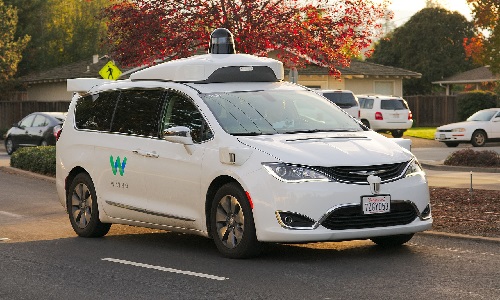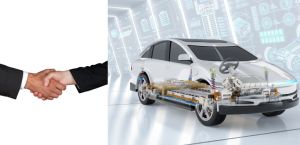By Jeff Sanford
Toronto, Ontario — May 14, 2018 — In this week’s AV Report: The race to launch AVs continues between the top OEMs, car manufacturers have a new nickname and much, much more!
One of the world’s premier business-focused newspapers is the Financial Times of London, England. This past week the paper ran a story suggesting that the automated vehicle (AV) subsidiary of Google, Waymo, “will own 60 percent of the global self-driving taxi market by 2030, a level of dominance that forces many of the world’s carmakers to adopt its technology.” The prediction is contained in a report prepared by investment bank, UBS. According to bank analysts, “estimated global revenues from self-driving technology by 2030 will be up to $2.8 trillion, with [Google’s] Waymo unit the global leader. Only a select handful of carmakers, such as Daimler and General Motors, will be able to operate their own systems and compete with Waymo’s technology.” The report uses the name of the holding company, Alphabet, which contains the many spinoffs from Google. The Alphabet umbrella now covers Google, Waymo and Sidewalk Labs. This last organization is the company that will develop a next-generation digital neighborhood in Toronto that will be designed to enable AVs. According to the story, UBS “expects 12 percent of cars sold in 2030 will be for driverless taxi fleets, with a total of 26 million robotaxis in operation. Private car sales will fall by 5 percent as a result.” The report predicts that demand for self-driving taxis will take off around 2026, “depending on public acceptance of the technology in the face of recent crashes, and regulatory approval, although it will develop at different speeds in different markets.” When AVs do take hold they’ll be using the Waymo ‘brain.’ According to the Times, “Sooner or later carmakers that are unable to compete will have to give in and take the Waymo system.” The story goes on to quote a UBS analyst who says, “the largest revenue pools will be in operating the car-booking networks and monetizing time spent by passengers in the cars, with building the cars and other services such as mapping or sensors taking a smaller portion of the driverless pie. But the costs of building a self-driving system from scratch, as well as the challenges of deploying it in cities across the world, will prohibit all but a handful of carmakers from competing in the most lucrative part of the market.” The basic prediction is that Google has won the race to develop an AV. The reason Google won the race, according to the Times, is that, “Unlike most auto players, Google focused on [full self-driving technology] from the very beginning – more than five years before the auto industry started working on it. Waymo has notched up more than 5 million miles of physical testing in California, as well as 5 billion miles of virtual testing on its computers, putting it far ahead of rivals.” By deciding to focus only on developing the computer brain (and leaving the building of cars to actual car companies) Waymo has managed to get the programming done. According to the story, “Very few players other than Waymo will be able to succeed with having an autonomous vehicle brain in the marketplace. Sooner or later carmakers that are unable to compete will have to give in and take the Waymo system. Those that do provide vehicles for driverless fleets may see their brands disappear from the cars, and be relegated to ‘white label’ providers that will lead to a shake-out in the industry over time and a reduction in the number of carmakers. We have dozens of carmakers around the world; it’s a fairly fragmented industry. The majority will be in the loser category.”
The CEO of Waymo, John Krafcik, this week gave a presentation at the company’s annual developer conference. He reportedly told the audience, “our cars can see further, perceive better and make snap decisions faster than anyone else.”
Uber continues to fall behind in the race to develop an AV. One of the company’s vehicles recently killed a pedestrian. Since then, the tech trade media has been discussing the event at length. The explanations for why it is the collision occurred provide some interesting insights into how it is AVs work. According to one of the reports, a “software bug in Uber’s self-driving car technology [was the cause]. Uber’s sensors did, in fact, detect [the pedestrian] as she crossed the street with her bicycle. Unfortunately, the software classified her as a ‘false positive’ and decided it didn’t need to stop for her. Software needs to detect objects like cars, pedestrians, and large rocks in its path and stop or swerve to avoid them. However, there may be other objects – like a plastic bag in the road or a trash can on the sidewalk – that a car can safely ignore. Sensor anomalies may also cause software to detect apparent objects where no objects actually exist. Software designers face a basic trade off here. If the software is programmed to be too cautious, the ride will be slow and jerky, as the car constantly slows down for objects that pose no threat to the car or aren’t there at all. Tuning the software in the opposite direction will produce a smooth ride most of the time – but at the risk that the software will occasionally ignore a real object. According to [a source], that’s what happened in Tempe in March – and unfortunately the ‘real object’ was a human being.” The source in the story went on to say, “There’s a reason Uber would tune its system to be less cautious about objects around the car. It is trying to develop a self-driving car that is comfortable to ride in.” According to another report, “The car’s sensors detected the pedestrian, who was crossing the street with a bicycle, but Uber’s software decided it didn’t need to react right away. That’s a result of how the software was tuned. Like other autonomous vehicle systems, Uber’s software has the ability to ignore ‘false positives,’ or objects in its path that wouldn’t actually be a problem for the vehicle, such as a plastic bag floating over a road. In this case, Uber executives believe the company’s system was tuned so that it reacted less to such objects. But the tuning went too far, and the car didn’t react fast enough.”
Several companies have suspended testing on roads in the wake of the accident. Toyota is one of those. The company is going to do the most dangerous tests on a track that the OEM is building. According to a news report, Toyota “will build a gigantic, 60-acre facility in Michigan to test ‘edge case’ driving scenarios with its autonomous vehicles that are too dangerous to perform on public roads. Construction permits were filed this week to transform a closed-course facility for the Toyota Research Institute, the car company’s Silicon Valley arm, to test its vehicles. The site will include congested urban environments, slick surfaces and a four-lane divided highway with high-speed entrance and exit ramps. When it becomes operational this October, the company will use the site to specifically test scenarios deemed too risky for public roads, most likely involving vehicles without a human driver.” According to a Toyota spokesperson, “Our pause in testing on public roads in California and Michigan has allowed us to further refine and upgrade our Platform 2.0/2.1 test-vehicle fleet, in line with the ongoing build-out of the Platform 3.0 fleet, introduced at this year’s [Consumer Electronics Show] in Las Vegas. We will resume testing on public roads in a few weeks, once these three systems have been more closely aligned. It’s important to note that our closed-course testing did not stop during this time.”
Speaking at an event, the CEO of Toyota referred to the company as a “mobility provider.” The term is the new trendy phrase auto execs are using to refer to auto industry OEMs. No longer are they car companies. As the OEMs offer ride-share fleets, they’ll be more than just manufacturers of vehicles. The term mobility provider gets to that point. In his address, the Toyota CEO talked about ‘embarking’ on a battle in an “Uber world of unknowns.” To prepare for this battle the CEO is quoted as saying, “I have decided to ‘redesign’ Toyota from a car-making company into a mobility company. A mobility company is a company that provides services related to movement for people around the world. The significance in this is that it represents a fork in our current path of adherence to convention as well as the choice of a future in which the path is created by one’s own hands. I view this once-in-a-century era of profound transformation, the likes of which come only so often, as a major opportunity, and I approach it as an endeavor to create a new future for ourselves with unprecedented speed and imagination.” It’s an amazing time to be involved in the auto industry.





































